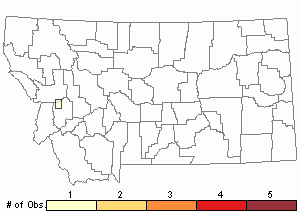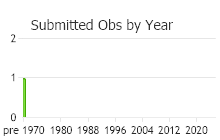View in other NatureServe Network Field Guides
NatureServe
Montana
Utah
Wyoming
Idaho
Wisconsin
British Columbia
South Carolina
Yukon
California
New York
Matted Squirrel-tail Moss - Sciuro-hypnum populeum
Other Names:
Pointed Mat Moss,
Brachythecium populeum
General Description
Plants: Pleurocarpous (Vitt 1988). Growing in open to crowded tufts, green, green with yellow tones, or ochre (FNA 2014), somewhat glossy (Crum and Anderson et al. 1981). Stems thick with foliage, prostrate, straight or a little bowed, appearing with the leaves circular in X-section, up to 5 cm in length; possessing a central strand (FNA 2014); occasionally stoloniferous, frequently with rhizoid bunches (Lawton 1971). Branches up to 7 mm in length, straight or a little bowed, together with the leaves appearing circular in X-section (FNA 2014).
Stem Leaves: Loosely upright to flat against the stem, tightly overlapping, 1.2-1.9 mm in length, 0.4-0.6 mm in width, lance-shaped with ovate tendencies, shallowly cupped, not or faintly pleated; margins finely saw-toothed to nearly smooth, flat or curved back and downward in various spots (more frequently below); apex slowly narrowing and forming a short acumen; costa 4/5 of the leaf length or more, sometimes percurrent, occasionally ending with a spine (FNA 2014).
Branch Leaves: Smaller and more slender than the stem leaves (FNA 2014), upright when dry, spreading slightly when moist (Crum and Anderson et al. 1981); costa with dorsal spine somewhat saw-toothed (FNA 2014).
Leaf Cells: Alar cells akin to cells adjacent to costa; laminal cells long and narrow, sometimes diamond-shaped; basal cells small and nearly square, opaque, arranged in 5 series (FNA 2014).
Diagnostic Characteristics
Typically living in lowlands, the only known highland population is in Colorado.
Sciuro-hypnum plumosum also has short, rather even cells across the base; however, the costa ends much below the apex. The costa of S. populeum is 80-100% of the leaf length (FNA 2014).
Range Comments
North American Range
Canada: BC and MB eastward; USA: known in many northeastern states, s to TN and NC, w to MN and IA, also AK and CO (FNA 2014). Known in Montana from Granite County (Elliott 2016).
Observations in Montana Natural Heritage Program Database
Number of Observations: 1
(Click on the following maps and charts to see full sized version)
Map Help and Descriptions
Relative Density

Recency


 (Observations spanning multiple months or years are excluded from time charts)
(Observations spanning multiple months or years are excluded from time charts)
Habitat
Limestone, soil, tree bases, dry and open to somewhat canopied areas. Elevation: 30-6560 feet (FNA 2014).
Reproductive Characteristics
Autoicous. Perichaetial leaves costate; the apex suddenly acuminate and spreading (Lawton 1971). Seta 0.8-1.5 cm tall, reddish, slightly to moderately papillae-roughened. Capsule 1-2 mm in length, ascending somewhat, slightly bowed on top (FNA 2014); cilia 2 or 3 in a group (Crum and Anderson et al. 1981).
Stewardship Responsibility
References
- Literature Cited AboveLegend:
 View Online Publication
View Online Publication Crum, H.A. and L.E. Anderson. 1981. Mosses of Eastern North America. 2 volumes. Columbia University Press, New York. 1328 pp.
Crum, H.A. and L.E. Anderson. 1981. Mosses of Eastern North America. 2 volumes. Columbia University Press, New York. 1328 pp. Elliott, J.C. and A.K. Pipp. 2018. A Checklist of Montana Mosses (1880-2018). Updated 3 January, 2020. Montana Natural Heritage Program, Helena, Montana. 73 pp.
Elliott, J.C. and A.K. Pipp. 2018. A Checklist of Montana Mosses (1880-2018). Updated 3 January, 2020. Montana Natural Heritage Program, Helena, Montana. 73 pp. Flora of North America Editorial Committee, eds. 2014. Flora of North America North of Mexico. Volume 28. Bryophytes: Mosses, Part 2. Oxford University Press, Inc., NY. xxi + 702 pp.
Flora of North America Editorial Committee, eds. 2014. Flora of North America North of Mexico. Volume 28. Bryophytes: Mosses, Part 2. Oxford University Press, Inc., NY. xxi + 702 pp. Lawton, E. 1971. Moss Flora of the Pacific Northwest. Hattori Botanical Laboratory. Japan: Yamabuki-cho, Shinjuku-ku, Tokyo. 362 pages plus appendices.
Lawton, E. 1971. Moss Flora of the Pacific Northwest. Hattori Botanical Laboratory. Japan: Yamabuki-cho, Shinjuku-ku, Tokyo. 362 pages plus appendices. Vitt, D. J. Marsh, and R. Bovey. 1988. Mosses, Lichens & Ferns of Northwest North America. Seattle, WA: University of Washington Press. 296 p.
Vitt, D. J. Marsh, and R. Bovey. 1988. Mosses, Lichens & Ferns of Northwest North America. Seattle, WA: University of Washington Press. 296 p.
- Additional ReferencesLegend:
 View Online Publication
View Online Publication
Do you know of a citation we're missing? Elliot, J. C. 1993. Second checklist of Montana mosses. Unpublished report. U.S. Forest Service, Region 1. Missoula, MT. 45 pp.
Elliot, J. C. 1993. Second checklist of Montana mosses. Unpublished report. U.S. Forest Service, Region 1. Missoula, MT. 45 pp. Lawton, E. 1971. Keys for the Identification of the Mosses on the Pacific Northwest. Reprinted from 'Moss Flora of the Pacific Northwest'. Published as Supplement No. 2 of the Journal of the Hattori Botanical Laboratory. Nichinan, Miyazaki, Japan. 66 pp.
Lawton, E. 1971. Keys for the Identification of the Mosses on the Pacific Northwest. Reprinted from 'Moss Flora of the Pacific Northwest'. Published as Supplement No. 2 of the Journal of the Hattori Botanical Laboratory. Nichinan, Miyazaki, Japan. 66 pp.
- Web Search Engines for Articles on "Matted Squirrel-tail Moss"





